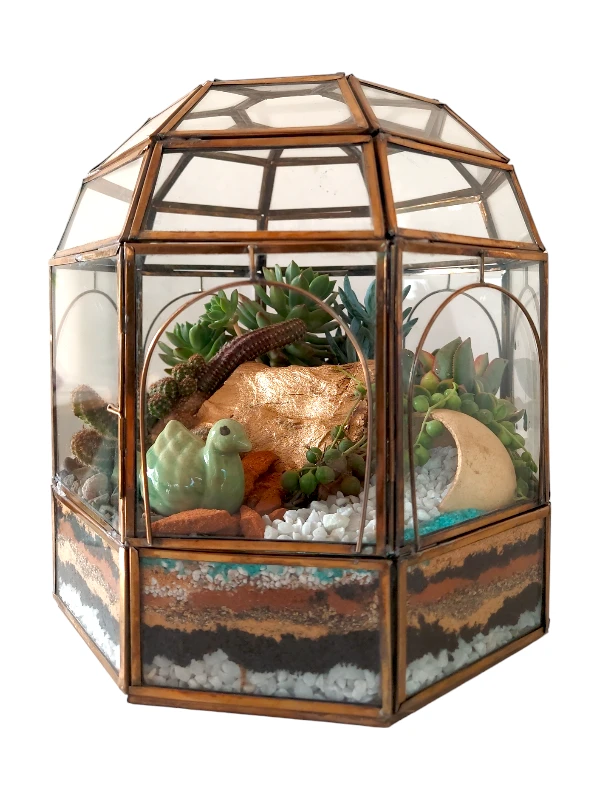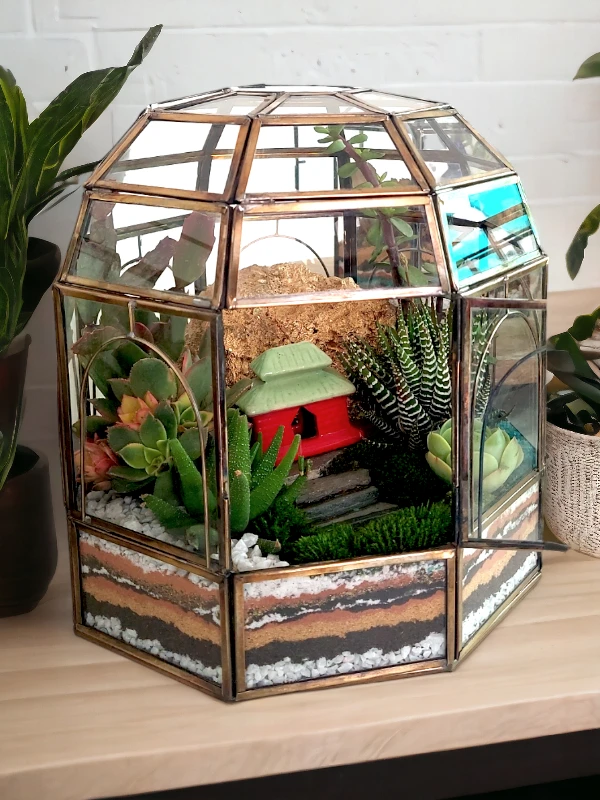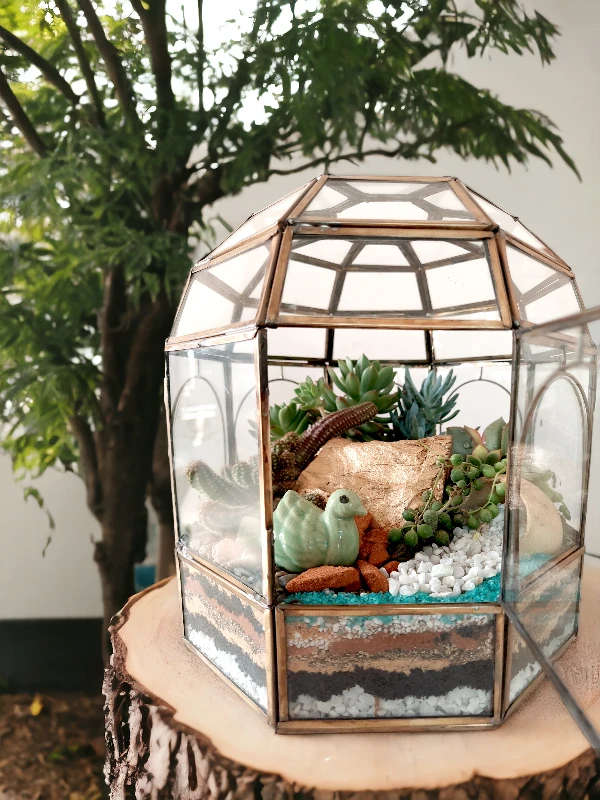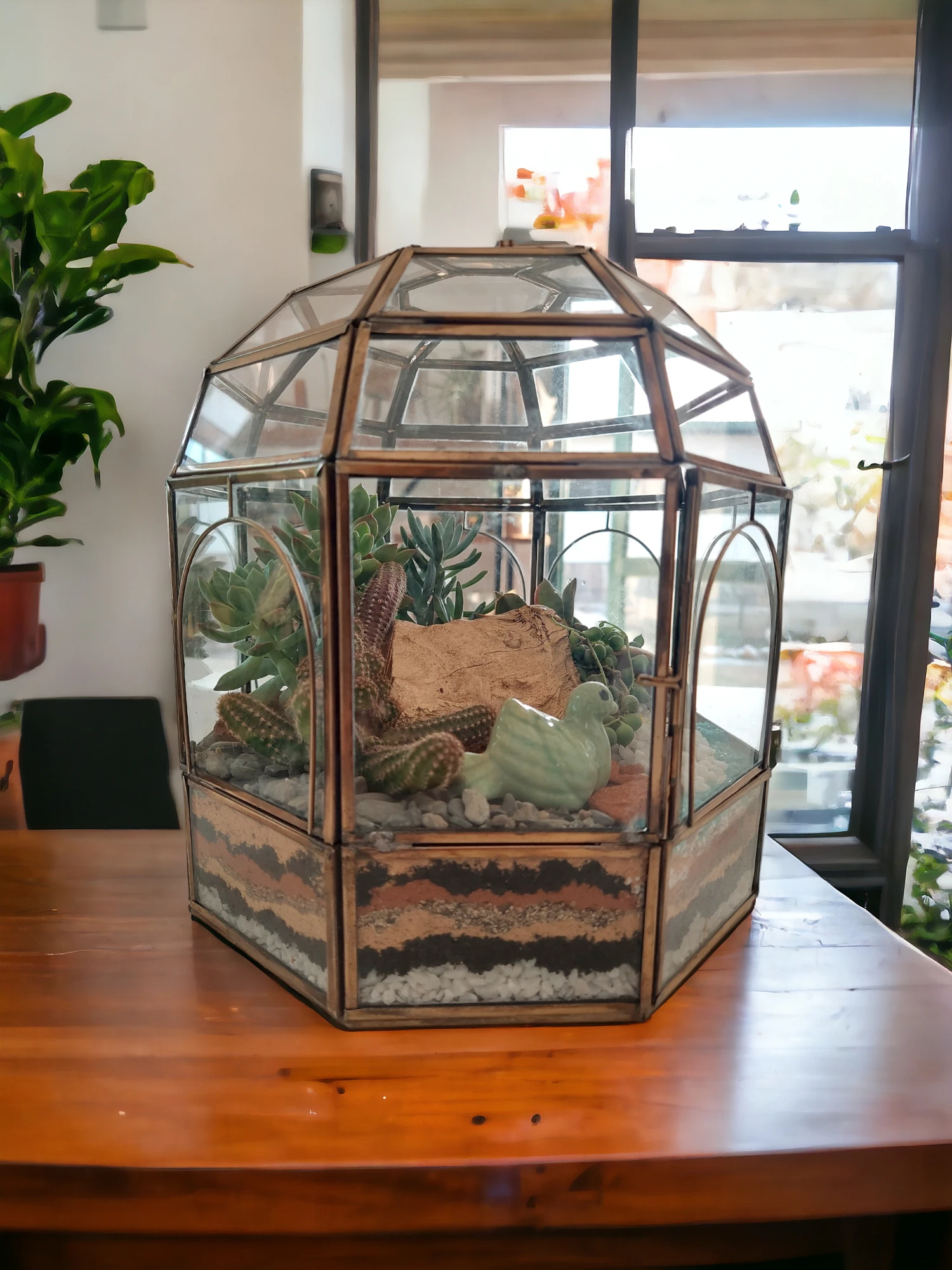Geometric Dome Glass House Terrarium
Original price was: ₹3,500.00.₹2,400.00Current price is: ₹2,400.00.-31% OFF
Geometric Dome Glass House Terrarium
Product Contains
- Geometric Dome Glass Houuse Terrarium
- Care Cards
- Water Bottle
Product Dimensions
Height: 9 inches
Width: 8 inches
Note: In deliveries outside Delhi NCR succulents will not be planted and instead will be given along with the product.
149 in stock
Description
Geometrical Dome Glass House Terrarium
The Beauty of Geometrical Dome Glass House Terrariums: Wild Roots
The dome shape provides ample space for a variety of plant species, allowing for a diverse and eye-catching display. Whether you prefer lush greenery or delicate succulents, WildRoots offers options that cater to different tastes and preferences. Beyond the Geometric Dome Glass House Terrarium aesthetic appeal, this is designed for easy maintenance. WildRoots understands the importance of creating a hassle-free experience for plant enthusiasts, making it accessible to both beginners and seasoned green thumbs alike. The dome shape of the glass house terrarium adds a touch of sophistication to the traditional terrarium, creating a unique focal point for any living space.
Ideal Indoor Locations for the Geometric Dome Glass House Terrarium
Placing your terrarium on tables, shelves, or windowsills allows for easy admiration. Optimal locations include spots near windows with indirect sunlight, ensuring plants receive the right amount of light without the risk of scorching. Additionally, consider bathrooms and kitchens for humidity-loving plants that thrive in such environments.
Watering in Geometric Dome Glass House Terrarium
- Choose the Right Plants: Ensure that the plants inside the terrarium have similar water and light requirements. This helps maintain a balanced environment.
- Monitor Moisture Levels: Check the moisture levels regularly. If the soil feels dry to the touch, it’s time to water.
- Use a Watering Can with a Narrow Spout: A narrow spout helps control the water flow, preventing overwatering and allowing you to target specific areas.
- Water Sparingly: Terrariums have a closed environment, so they retain moisture well. Avoid overwatering, as this can lead to fungal growth or root rot.
- Water at the Base: Direct water at the base of the plants to reach the roots. Avoid spraying water on the glass walls, as this can lead to a buildup of algae.
- Consider the Terrarium Size: Adjust the amount of water based on the size of your terrarium. Larger terrariums may need more water, but always start with a small amount and observe how the plants respond.
- Use Filtered or Distilled Water for the glass house terrarium plants: If possible, use filtered or distilled water to prevent the accumulation of mineral deposits on the glass and soil.
- Maintain Adequate Drainage: Ensure that your terrarium has proper drainage, such as a layer of gravel or activated charcoal at the bottom. This helps prevent waterlogged soil.
- Observe Plant Responses: Watch how your plants respond to watering. If they show signs of stress or if the terrarium becomes foggy, you may need to adjust your watering routine.
- Seasonal Adjustments: Be mindful of seasonal changes. Plants may have different water requirements during different times of the year.
Sunlight Requirement of Geometric Dome Glass House Terrarium
- Indirect Light: Most terrarium plants prefer indirect sunlight. Placing the terrarium near a bright, filtered light source is ideal. Avoid placing it in direct, intense sunlight, as this can lead to overheating and scorching of the plants.
- Filtered Light: The glass of the Geometric Dome Glass House Terrarium already acts as a filter for sunlight, but you can further diffuse light by placing sheer curtains or using frosted glass. This helps create a more even distribution of light inside.
- Rotate the Terrarium: To ensure even exposure to light, periodically rotate the Geometric Dome Glass House Terrarium. This prevents plants from leaning towards the light source and promotes balanced growth.
- Monitor Light Levels: Observe how your plants respond to the current light conditions. If they appear leggy or show signs of stretching towards the light, it may indicate that they need more illumination.
- Consider Artificial Light: In situations where natural light is limited, you can supplement with artificial light. LED grow lights or fluorescent lights designed for plants can provide the necessary spectrum for photosynthesis.
- Adapt to Plant Preferences: Different plants have varying light requirements. Some may thrive in low light, while others need more intense illumination. Choose plants that have similar light preferences to create a harmonious environment.
- Avoid Overexposure: While light is essential for photosynthesis, too much direct sunlight can lead to overheating inside the terrarium. Keep an eye on the temperature, especially if your terrarium is placed in a sunny spot.
- Seasonal Adjustments: Be aware of seasonal changes in sunlight. The angle and intensity of sunlight can vary throughout the year, so you may need to adjust the placement of your terrarium to accommodate these changes.
FAQs: Answering Your Curiosities
Let’s address some common queries about the described Geometric Dome Glass House Terrarium by Wild Roots.
Are Wild Roots Terrariums Suitable for All Plants?
Absolutely. The Geometric Dome Glass House Terrariums are versatile and accommodate various plant species. From low-maintenance succulents to more delicate ferns, Wild Roots provides a suitable environment for diverse flora.
How Often Should I Water My Terrarium?
The frequency depends on the plant species within your Geometric Dome Glass House Terrarium. Generally, a light misting every two weeks is sufficient. Wild Roots provides detailed care instructions to ensure your plants thrive.
Can I Place the Terrarium in Direct Sunlight?
While some plants thrive in direct sunlight, prolonged exposure can lead to overheating. It’s advisable to place your terrarium in indirect sunlight to maintain a balanced and healthy environment.
Are Wild Roots Terrariums Pet-Friendly?
Yes, most definitely. The terrariums are a haven for plants, and their design prevents easy access for curious pets. It’s a harmonious addition to pet-friendly households.
Do I Need a Green Thumb to Maintain a Terrarium?
Not at all. Wild Roots terrariums are designed for plant enthusiasts of all levels. The low-maintenance nature of the ecosystem makes it easy for beginners to cultivate their green oasis.
Can I Move My Terrarium Around Frequently?
While it’s best to find a suitable spot and leave it be, occasional movement is acceptable. However, sudden shifts in light conditions or temperature may affect plant health, so mindful placement is key.
Check out a perfect bonsai gift for bonsai lovers. “Click Here”
Specifications
| Select | Buy New, Remake already bought |
|---|





Reviews
There are no reviews yet.